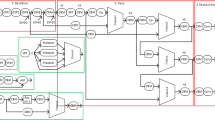Abstract
In recent years, deep learning especially deep convolutional neural networks (DCNN) has made great progress. Many researchers take advantage of different DCNN models to do object detection in remote sensing. Different DCNN models have different advantages and disadvantages. But in the field of remote sensing, many scholars usually do comparison between DCNN models and traditional machine learning. In this paper, we compare different state-of-the-art DCNN models mainly over two publicly available remote sensing datasets—airplane dataset and car dataset. Such comparison can provide guidance for related researchers. Besides,we provide suggestions for fine-tuning different DCNN models. Moreover, for DCNN models including fully connected layers, we provide a method to save storage space.






Similar content being viewed by others
References
Hong C, Yu J, Wan J, Tao D, Wang M (2015) multimodal deep autoencoder for human pose recovery. IEEE Trans Image Process 24(12):5659–5670
Hong C, Yu J, Chen X (2013) Image-based 3D human pose recovery with locality sensitive sparse retrieval. In: Systems, man and cybernetics, pp 2103–2108
LeCun Y, Bengio Y, Hinton G (2015) Deep learning. Nature 521(7553):436–444. https://doi.org/10.1038/nature14539
Schmidhuber J (2015) Deep learning in neural networks: an overview. Neural Netw 61:85–117. https://doi.org/10.1016/j.neunet.2014.09.003
Lecun Y, Bottou L, Bengio Y, Haffner P (1998) Gradient-based learning applied to document recognition. Proc IEEE 86(11):2278–2324
Srivastava N, Hinton GE, Krizhevsky A, Sutskever I, Salakhutdinov R (2014) Dropout: a simple way to prevent neural networks from overfitting. J Mach Learn Res 15(1):1929–1958
Glorot X, Bordes A, Bengio Y (2011) Deep sparse rectifier neural networks. In: AISTATS, pp 315–323
Szegedy C, Liu W, Jia Y, Sermanet P, Reed S, Anguelov D, Erhan D, Vanhoucke V, Rabinovich (2015) A Going deeper with convolutions. In: Computer vision and pattern recognition, pp 1–9
He K, Zhang X, Ren S, Sun J (2015) Deep residual learning for image recognition. In: Computer vision and pattern recognition, pp 770–778
Zisserman KSAA (2015) Very deep convolutional networks for large-scale image recognition. In: International conference on learning representations (ICLR)
Chen X, Xiang S, Liu CL, Pan CH (2014) Vehicle detection in satellite images by hybrid deep convolutional neural networks. IEEE Geosci Remote Sens Lett 11(10):1797–1801. https://doi.org/10.1109/LGRS.2014.2309695
Zhang QJ, Xu JL, Xu L, Guo HF (2016) Deep convolutional neural networks for forest fire detection. In: Kim YH (ed) Proceedings of the 2016 international forum on management, education and information technology application, vol 47. Advances in social science education and humanities research, pp 568–575. Atlantis Press, Paris
Hafemann LG, Oliveira LS, Cavalin PR (2014) Forest species recognition using deep convolutional neural networks. In: International conference on pattern recognition, pp 1103–1107
Castelluccio M, Poggi G, Sansone C, Verdoliva L (2015) Land use classification in remote sensing images by convolutional neural networks. In: Computer science
Lecun Y, Kavukcuoglu K, Farabet C (2010) Convolutional networks and applications in vision. In: International symposium on circuits and systems, pp 253–256
Scherer D, Muller A, Behnke S (2010) Evaluation of pooling operations in convolutional architectures for object recognition. In: International conference on artificial neural networks
Girshick R, Donahue J, Darrell T, Malik J, Ieee (2014) Rich feature hierarchies for accurate object detection and semantic segmentation. In: 2014 IEEE conference on computer vision and pattern recognition, pp 580–587. IEEE, New York. https://doi.org/10.1109/cvpr.2014.81
Zeiler MD, Fergus R (2014) Visualizing and understanding convolutional networks. In: Fleet D, Pajdla T, Schiele B, Tuytelaars T (eds) Computer vision-ECCV 2014: 13th European conference, Zurich, Switzerland, September 6–12, 2014, proceedings, part I. Springer, Cham, pp 818–833. https://doi.org/10.1007/978-3-319-10590-1_53
Lin M, Chen Q, Yan S (2013) Network in network. arxiv:1312.4400
Iandola FN, Han S, Moskewicz MW, Ashraf K, Dally WJ, Keutzer K (2016) SqueezeNet: AlexNet-level accuracy with 50x fewer parameters and < 0.5 MB model size. arXiv:1602.07360
Jia Y, Shelhamer E, Donahue J, Karayev S, Long J, Girshick R, Guadarrama S, Darrell T (2014) Caffe: convolutional architecture for fast feature embedding. In: ACM multimedia, pp 675–678
Bottou L (2010) Large-scale machine learning with stochastic gradient descent. In: Lechevallier Y, Saporta G (eds) Proceedings of COMPSTAT’2010: 19th International Conference on computational statistics, Paris France, August 22–27, 2010 Keynote, invited and contributed papers, pp 177–186. Physica-Verlag HD, Heidelberg. https://doi.org/10.1007/978-3-7908-2604-3_16
Bottou L (2012) Stochastic gradient descent tricks. In: Montavon G, Orr GB, Müller K-R (eds) Neural networks: tricks of the trade, 2nd edn. Springer, Berlin, pp 421–436. https://doi.org/10.1007/978-3-642-35289-8_25
Acknowledgements
This work was supported by the project of National Science Fund for Distinguished Young Scholars of China (Grant No. 60902067) and the Key Science-Technology Project of Jilin Province (Grant No. 11ZDGG001).
Author information
Authors and Affiliations
Corresponding authors
Additional information
Publisher’s Note
Springer Nature remains neutral with regard to jurisdictional claims in published maps and institutional affiliations.
Rights and permissions
About this article
Cite this article
Ding, P., Zhang, Y., Jia, P. et al. A Comparison: Different DCNN Models for Intelligent Object Detection in Remote Sensing Images. Neural Process Lett 49, 1369–1379 (2019). https://doi.org/10.1007/s11063-018-9878-5
Published:
Issue Date:
DOI: https://doi.org/10.1007/s11063-018-9878-5




